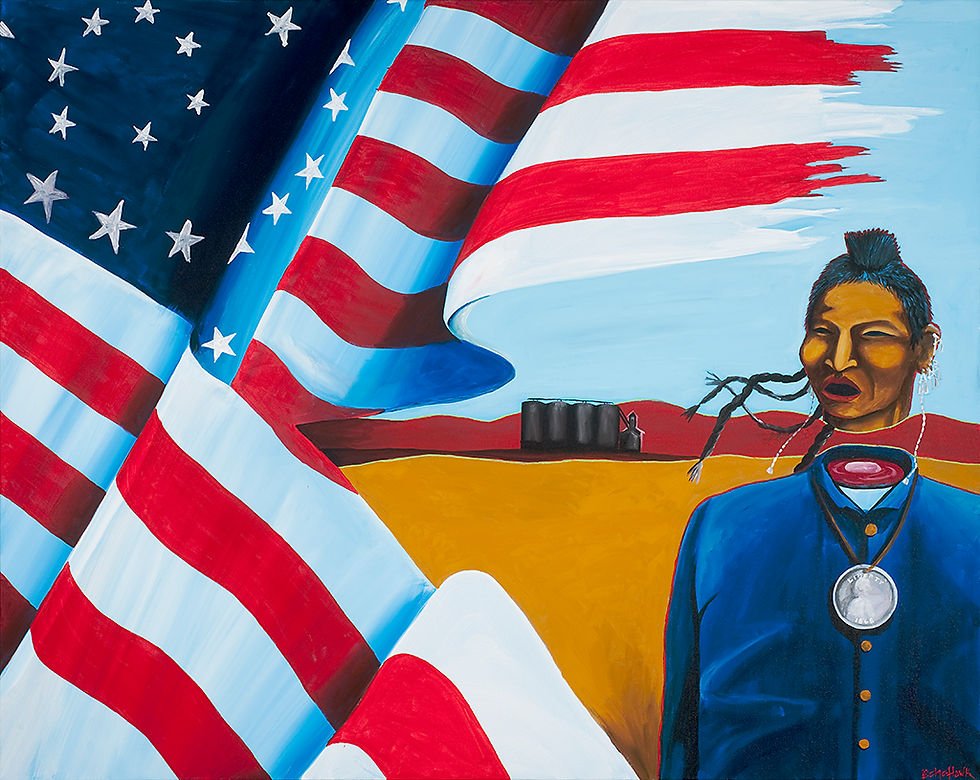Promised or Stolen Land? Indian Education by Sherman Alexie
- Aylin Usta

- Dec 18, 2021
- 5 min read
Updated: Dec 19, 2021
Before the white European settlers came to the United States of America, there were indigenous people now known as Native Americans, and when Christopher Columbus’ ships landed in the Bahamas, various groups of people had already discovered America. The indigenous peoples of the Americas migrated from Sub-Saharan Africa and inhabited North and South America. The migratory ancestors of the Native Americans came from Asia to what is now Alaska more than 12,000 years ago. Due to the huge diversity among tribes, it is hard to detect the ancestor of every tribe. However, studies continue to investigate the Native Americans’ origin and the lives of the living Natives who managed to escape from the brutal conditions that were imposed on them. The debate is that while the United States of America asserts that they came to this ‘’promised land’’ in the hope of finding a new life, they caused such drastic destruction on the part of Native Americans. Is the land truly 'promised' or stolen from Natives? Rather than learning the conditions of the land and traditions, they forced the Natives to abandon their homes. Sherman Alexie is a Native American poet, novelist, performer and filmmaker, also representative of the ‘’Indigenous Nationalism’’ movement, handles these issues in his short story ‘’Indigenous School’’ in a poetic and also thought-provoking way. Just like the narrator, Alexie went to an Indian school for the primary grades. His experience is why his expressions are sharper and more provocative.
Portrait of Sherman Alexie
As white settlers were searching for more land to capture, their eye were riveted towards the land held by the Native Americans. With the promotion of United States policy which was ''Westward Expansion'', they began to search for lands to capture. In 1851, American Congress enforced the Indian Appropriations Act which created the Indian reservation system and provided funds to move Indian tribes onto farming reservations to keep them under control. Moreover, Indians were not allowed to leave the reservations without permission. As Howard University Law Library mentions:
Following the divestment and removal of Native Americans from their homelands, the federal government restricted tribal members to reservations, which are legally defined portions of land allocated to federally recognized tribes. Removal and settlement on reservations served two purposes for the United States. First, it cleared the land of Native Americans for western expansion. Second, it permitted the United States to carry out a program of Americanizing Tribes into communities of small farmers.'' (A brief history of civil rights in the United States: The Reservation Era 1850 - 1887).
The main goal of Indian reservations was to get Native Americans under the control of the U.S. government. The policy not only restricted Natives to a residential area but also forced Native Americans to talk in English, and change their religion to Christianity. Wearing their traditional clothes was no longer proper, long hair was not convenient, and most importantly they were coaxed by white settlers to consume alcohol. Enrolling Indian children in boarding schools was one of the policies which was designed for assimilation and to make them forget about their heritage. Children were given Anglo names instead of Native names. Their Native languages and cultural practices were prohibited. As Michelle M. Jacob underlines in Indigenous Studies Speaks to American Sociology: The Need for Individual and Social Transformations of Indigenous Education in the USA:
In theorizing the underpinnings of American Indians’ poor education outcomes, I argue that U.S. education systems are extensions of settler colonial logics and power structures. This history of Indian education in the U.S. is one stained with cultural and physical genocide. Historically, U.S. policies have dispossessed Indigenous people from our homelands, with policies of forced removal, reservation containment, and Indian boarding schools. (Jacob, 2).
Native Americans experienced disastrous incidents in reservations, and these incidents left devastating, long-lasting marks.
Shosone at Ft. Washakie reservation in Wyoming, 1892. Image courtesy National Archives.
The story Indian Education narrates the experiences of the protagonist, Victor, from the viewpoint of an Indian boy. Sherman Alexie wants to instruct readers on what it means to grow up as a Native American in a reservation. Several themes are included in the story like starvation, resilience, discrimination, alcoholism, poverty, hopelessness, racism, and inequality. In this way, the story shows how hard it was for Victor to grow up in a reservation. Victor explains to the reader the horrors associated with reservation life. First Grade Victor writes: ‘’I was always falling down; my Indian name was Junior Falls Down. Sometimes it was Bloody Nose or Steal-His-Lunch. Once, it was Cries-Like-a White-Boy, even though none of us had seen a white boy cry’’ (Alexie, 89). This quotation demonstrates that, even among Native Americans, there was discrimination towards Victor. He was bullied by other children and excluded by them. Racism and bullying are both present in the course of the chapters. ‘’In third grade, though, I stood alone in the corner, faced the wall, and waited for the punishment to end. I'm still waiting’’ (Alexie, 90). He describes how he was exposed to unfair judgements. Moreover, these assumptions never stopped and he consistently had to face barriers that came up along the way. He explicitly expresses that being a Native American brought stereotypes that he had to fight against. It is obvious that he struggled with many difficulties and was frustrated by growing up as an American Indian in a place like an Indian School. Judgemental statements like: ‘’You always look guilty’’ (Alexie, 90) prove the fact that the Natives are put in a pigeonhole, often seen as criminals. In the fifth grade, Victor writes: ‘’Oh, do you remember those sweet, almost innocent choices that the Indian boys were forced to make?’’ It is evident that they were not willingly enrolling at the boarding school to get an education. There was no avenue for the Native children to express themselves. According to the government, they had to convert to a way of life that had nothing to do with their past. It was nearly impossible for them to protect their culture and traditions.
In 1879, U.S. cavalry captain Richard Henry Pratt opened a boarding school in Pennsylvania called the Carlisle Indian Industrial School
The story is a portrait of the mistreatment and hardships that were imposed upon the Natives in the United States. They were determined to cut off the history of the Native Americans by means of forced education. The reader can see the damaging effects from the eyes of the little child, all because of his identity, and how he eventually lost his self-reliance by being forced into things that he never wanted to do.
''Homecoming'' by Bunky Echo-Hawk
References
Alexie, Sherman, The Lone Ranger and Tonto Fistfight in Heaven, Grove Press; 20th Anniversary edition (October 8, 2013)
''The Reservation Era (1850 - 1887)'', Howard University Law Library retrieved https://library.law.howard.edu/civilrightshistory/indigenous/reservation ( December 14, 2021)
Jacob, Michelle M, Indigenous Studies Speaks to American Sociology: The Need for Individual and Social Transformations of Indigenous Education in the USA, Department of Education Studies, 5277 University of Oregon, Eugene, OR 97403, USA
Dokuz Eylül University, AKE 4045 - The American West, Lecture Notes, 2021
Image References
Sherman Alexie [Photography] https://ndla.no/subject:1:4ad7fe49-b14a-4caf-8e19-ad402d1e2ce6/topic:1:30b499d3-65af-4341-872c-2b13893ff7ab/topic:1:e7a3b6cc-833d-42c0-97d3-78d95c99b7ca/resource:1:28240
Shosone at Ft. Washakie reservation in Wyoming, 1892 [Photography] https://www.khanacademy.org/humanities/us-history/the-gilded-age/american-west/a/the-reservation-system
Carlisle Indian Industrial School [Photography] https://www.history.com/topics/native-american-history/native-american-timeline#&gid=ci0236e6c1d0002658&pid=1_native-american_assimilation-school_carlisle-indian_3a51829u
''Homecoming'' by Bunky Echo-Hawk [Illustration] https://spencerart.ku.edu/node/1565











Really nice and eye-opening article. Such a pity first peoples are so often forgotten!